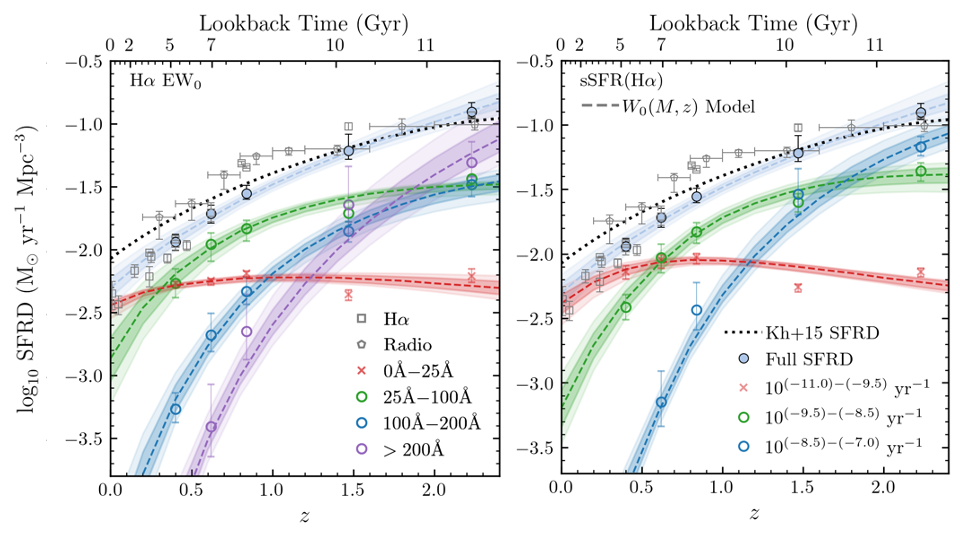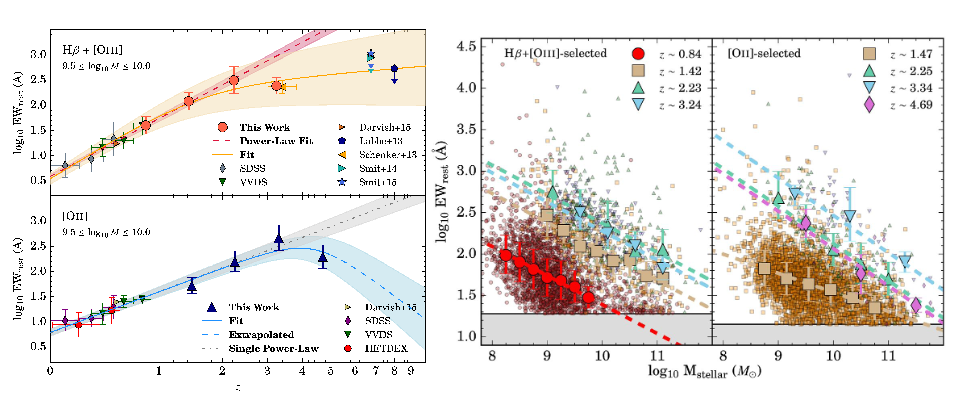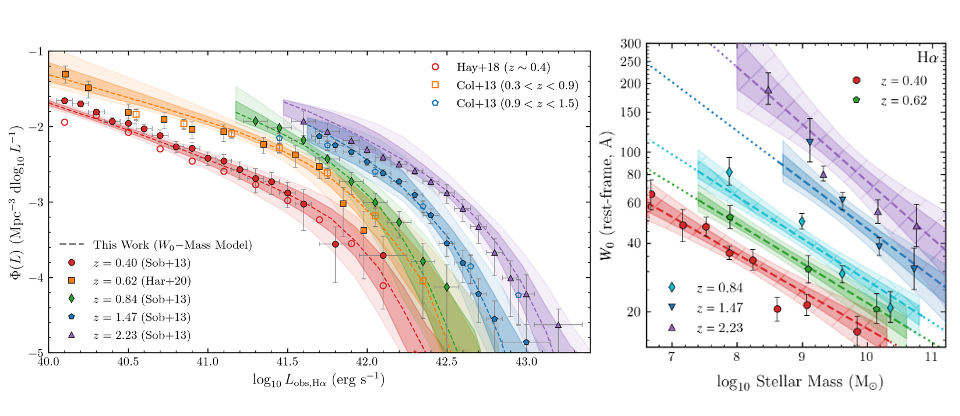Extreme Emission Line Galaxies at z ~ 0.4 - 2.2 and Equivalent Width Evolution
Research | | Links: LAGER EW Paper I | HiZELS EW

Cosmic Star Formation Rate Khostovan 2015.
EELGs are unique subsets of bursty, star-forming galaxies characterized by high equivalent widths (EWs) and may be important ionizing contributors at Epoch of Reionization. At \(z > 3\), high EWs may represent an initial burst of star formation followed by lower EWs with increasing continuum light (stellar mass) over cosmic time. Studying such sources can give us valuable insight on rapid galaxy growth and extreme ISM conditions.
 Left: The evolution of typical [OIII] and [OII] equivalent widths for a given stellar mass range Khostovan et al. (2016). Right: The EW - stellar mass anti-correlation for [OIII] and [OII] emitters highlighting the importance of low-mass galaxies with increasing redshift.
Left: The evolution of typical [OIII] and [OII] equivalent widths for a given stellar mass range Khostovan et al. (2016). Right: The EW - stellar mass anti-correlation for [OIII] and [OII] emitters highlighting the importance of low-mass galaxies with increasing redshift.
In Khostovan et al. 2016, I led an investigation of HiZELS-selected [OIII] and [OII] emitters finding their typical EW increases up to \(z \sim 3\) and \(5\), respectively, suggesting emitters with high EW are common in the high-\(z\) Universe and similar to extreme galaxies at low-\(z\). This would suggest that typical high-\(z\) galaxies have energetic ISM conditions most likely fueled by young stellar populations and intense bursts of star-formation activity.
 Left: The predicted Hα Luminosity Functions based on our \(W_0(M,z)\) model that describes the intrinsic Hα EW distributions (Khostovan et al., submitted). Right: The Intrinsic EW - stellar mass anti-correlation for Hα emitters which shows a steeper anti-correlation slope with redshift (faster evolution in typical EWs).
Left: The predicted Hα Luminosity Functions based on our \(W_0(M,z)\) model that describes the intrinsic Hα EW distributions (Khostovan et al., submitted). Right: The Intrinsic EW - stellar mass anti-correlation for Hα emitters which shows a steeper anti-correlation slope with redshift (faster evolution in typical EWs).
More recently, I developed a forward modeling approach to measure the ‘intrinsic’ \(z = 0.47\) Hα equivalent width distribution and highlighted how selection biases can result in steeper Hα~EW – stellar mass anti-correlations (Khostovan et al. (2021)). This was expanded to Hα emitters from \(z \sim 0.4\) to \(2.2\) (Khostovan et al., submitted) where we find Hα EW increases as \((1+z)^{1.8}\) and becomes steeper with decreasing stellar mass. Interestingly, EW\(_0 >200\) Å \(z > 1.5\) Hα emitters were found to contribute \(40\%\) of total cosmic star formation (main figure) suggesting low-mass, high EW ELGs could be strong ionizing sources given their relative contribution to cosmic SF. Using this approach, I forecasted Roman & Euclid surveys highlighting how both will observe numerous \(>1000\) Å EELGs and give valuable insight into \(z \sim 1 - 2\) bursty star-forming galaxies.
